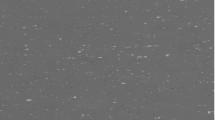Abstract
As demonstrated within the last 15 years by numerous experimental studies, tensile fracture surfaces exhibit a self-affine fractal geometry in many different materials and loading conditions. In the last few years, some authors proposed to explain an observed size effect on fracture energy by this fractality. However, because they did not consider a lower bound to this scale invariance (which necessarily exists, at least at the atomic scale), they had to introduce a new definition of fracture energy with unconventional physical dimensions. Moreover, they were unable to reproduce the observed asymptotic behavior of the apparent fracture energy at large specimen sizes. Here, we show that this is because they considered self-similar fracture surfaces (not observed in nature) instead of self-affine. It is demonstrated that the ignorance of the self-affine roughness of fracture surfaces when estimating the fracture energy from the work spent to crack a specimen necessarily leads, if the work of fracture is proportional to the fracture area created, to a size effect on this fracture energy. Because of the self-affine (instead of self-similar) character of fracture surfaces, this size effect follows an asymptotic behavior towards large scales. It is therefore rather limited and not likely detectable for relatively large sample sizes (≳10−1 m). Consequently, significant and rapid increases of the apparent fracture energy are more likely to be explained mainly by other sources of size effect.
Similar content being viewed by others
REFERENCES
Balankin, A. S., Matamoros, D. M. and Campos, I. (2000). Intrinsic nature of anomalous crack roughening in an anisotropic brittle composite. Philos. Mag. Lett., submitted.
Bazant, Z. P. (1997). Scaling of quasibrittle fracture: hypotheses of invasive and lacunar fractality, their critique and Weibull connection. International Journal of Fracture 83, 41–65.
Bazant, Z. P. and Planas, J. (1998). Fracture and Size Effect in Concrete and Other Quasibrittle Materials. CRC Press, Boca Raton.
Borodich, F. M. (1992). Fracture energy in a fractal crack propagating, Transactions of the Russian Academy of Sciences: Earth Siences Section 327, 36–40.
Borodich, F. M. (1997). Some fractal models of fracture, Journal of Mechanical and Physics Solids 45, 239–259.
Borodich, F. M. (1999). Fractals and fractal scaling in fracture mechanics, International Journal of Fracture 95, 239–259.
Bouchaud, E. (1997). Scaling properties of cracks, J. Phys. Condens. Matter 9, 4319–4344.
Bouchaud, E., Lapasset, G., and Planès, J. (1999). Fractal dimension of fractured surfaces: a universal value?, Europhysics Letters 13, 73–79.
Brameshuber, W. and Hilsdorf, H. K. (1990). Influence of ligament length and stress state on fracture energy of concrete, Engineering Fracture Mechanics 35, 95–106.
Carpinteri, A. (1994). Scaling laws and renormalization groups for strength and toughness of disordered materials, International Journal of Solids Structures 31, 291–302.
Dauskardt, R. H., Haubenak, F., and Ritchie, R. O. (1990). On the interpretation of the fractal character of fracture surfaces, Acta Metall. Mater. 38(2), 143–159.
Family, F. and Viscek, T. (1988). Scaling of the active zone in the Eden process on percolation networks and the ballistic deposition model, J. Phys. A: Math. Gen. 18, L75–L81.
Feder, J. (1988). Fractals, Plenum Press, New York.
Korvin, G. (1992). Fractal Models in the Earth Sciences, Elsevier, Amsterdam.
Lopez, J. M. and Schmittbuhl, J. (1998). Anomalous scaling of fracture surfaces, Phys. Rev. E 57, 6405–6408.
Mandelbrot, B. (1967). How long is the coast of Britain? Statistical self-similarity and fractional dimension, Science 156, 636–638.
Mandelbrot, B., Passoja, D. E., and Paullay, A. J. (1984). Fractal character of fracture surfaces of metals, Nature 308, 721–722.
Morel, S., Schmittbuhl, J., Bouchaud, E., and Valentin, G. (2000). Scaling of crack surfaces and implications on fracture mechanics, Physics Review Letters, in press.
Russ, J. C. (1994). Fractal Surfaces, Plenum Press, New York.
Scavia, C. (1996). The effect of scale on rock fracture toughness: a fractal approach, Géotechnique 46, 683–693.
Schmittbuhl, J. and Maloy, K. J. (1997). Direct observation of a self-affine crack propagation, Physics Revue Letters 78, 3888–3891.
Schmittbuhl, J., Roux, S., and Berthaud, Y. (1994). Development of roughness in crack propagation, Europhysics Letters 28, 585–590.
Schmittbuhl, J., Roux, S., Vilotte, J.P., and Maloy, K.J. (1995a). Interfacial crack pinning: Effect of nonlocal interactions. Physics Revue Letters 74, 1787–1790.
Schmittbuhl, J., Schmitt, F., and Scholz, C. (1995b). Scaling invariance of crack surfaces, J. Geophys. Res. 100, 5953–5973.
Schmittbuhl, J., and Vilotte, J.P. (1999). Interfacial crack front wandering: influence of quenched noise correlations, Physica A 270, 42–56.
Schmittbuhl, J., Vilotte, J.P., and Roux, S. (1995c). Reliability of self-affine measurements, Physical Review E 51, 131–147.
Turcotte, D. L. (1992). Fractals and chaos in geology and geophysics, Cambridge University Press, Cambridge.
Weiss, J. (2000). Fracture and fragmentation of ice: a fractal analysis of scale invariance, Engineering Fracture Mechanics, in press.
Wittmann, F. H., Mihashi, H., and Nomura, N. (1990). Size effect on fracture energy of concrete, Engineering Fracture Mechanics 35, 107–115.
Author information
Authors and Affiliations
Rights and permissions
About this article
Cite this article
Weiss, J. Self-affinity of fracture surfaces and implications on a possible size effect on fracture energy. International Journal of Fracture 109, 365–381 (2001). https://doi.org/10.1023/A:1011078531887
Issue Date:
DOI: https://doi.org/10.1023/A:1011078531887




